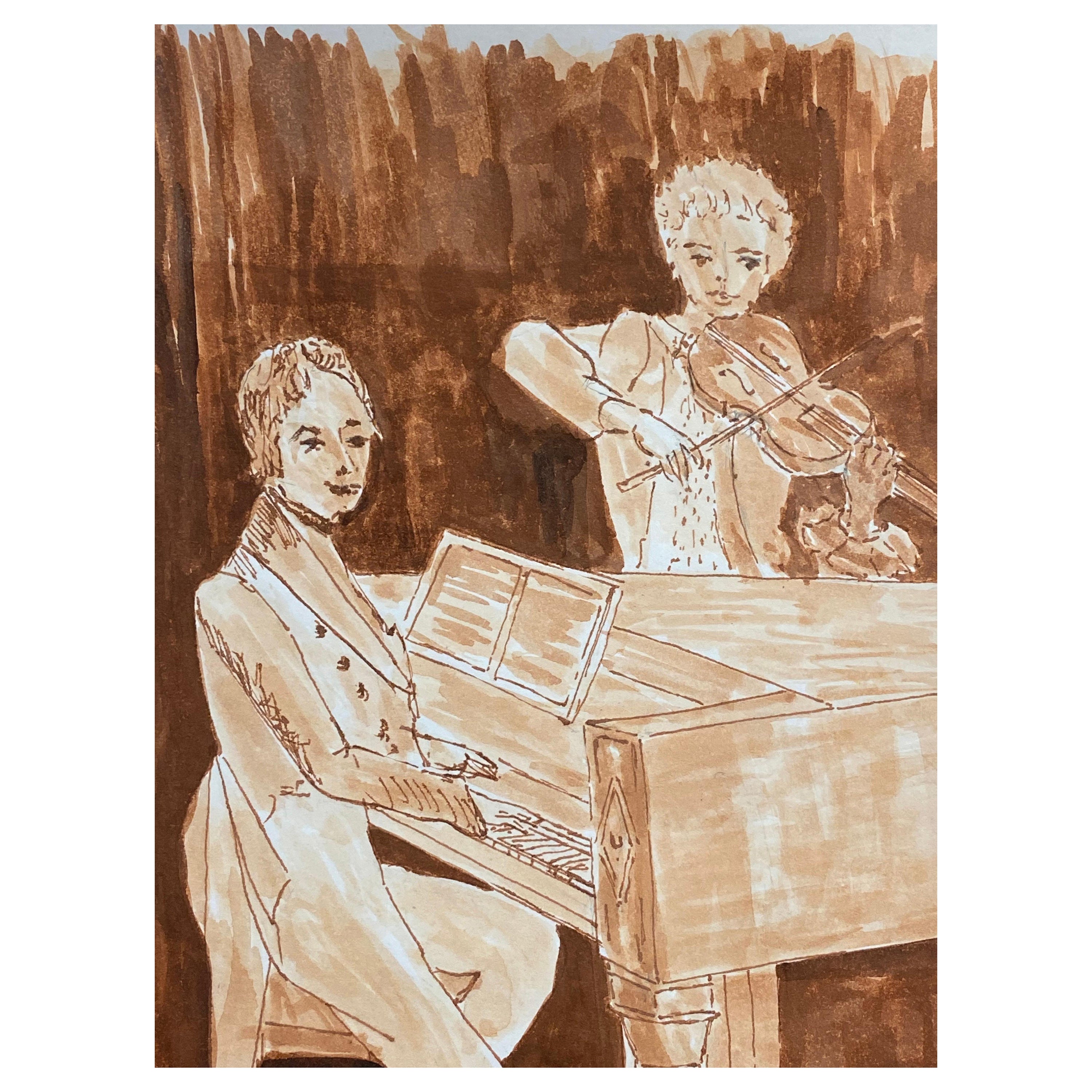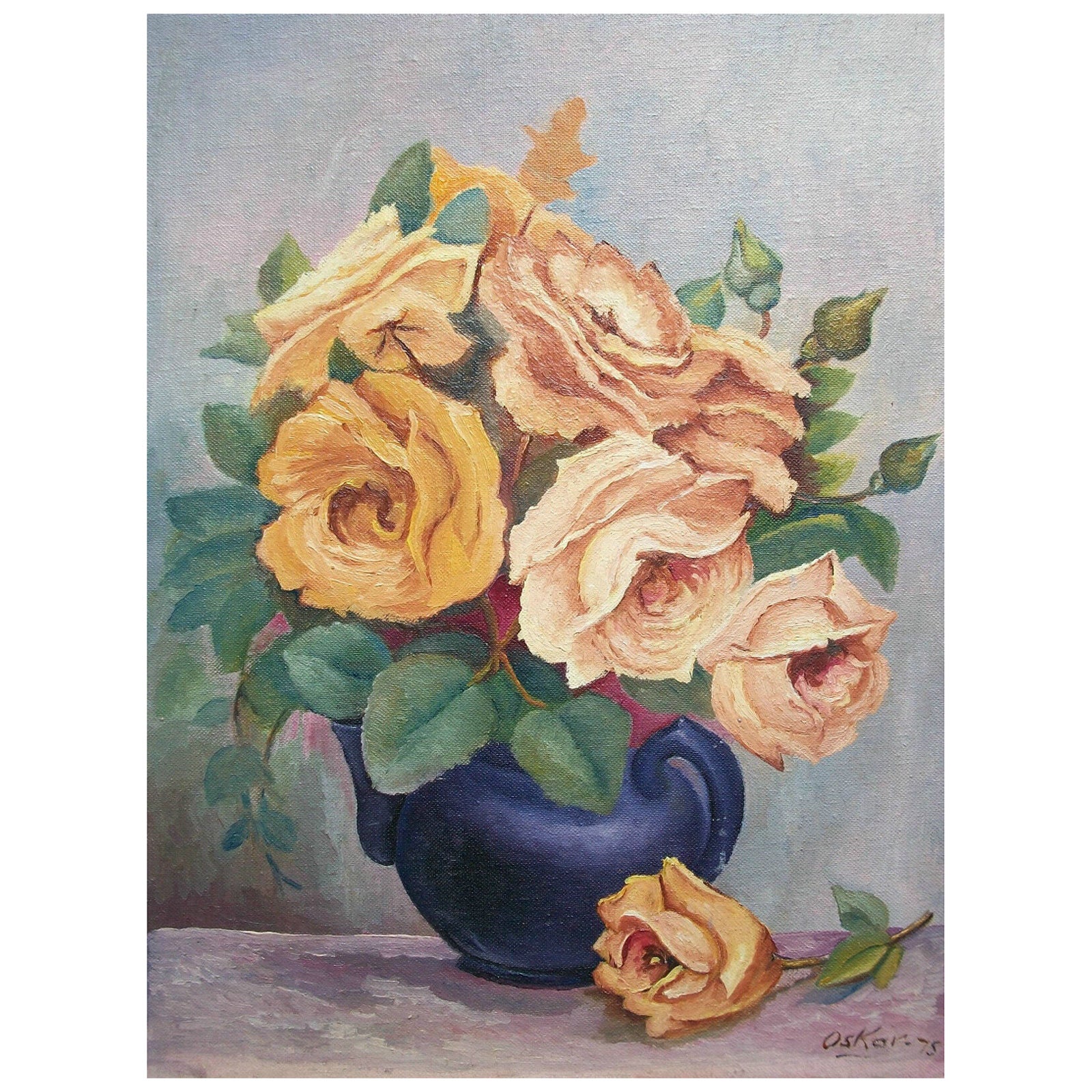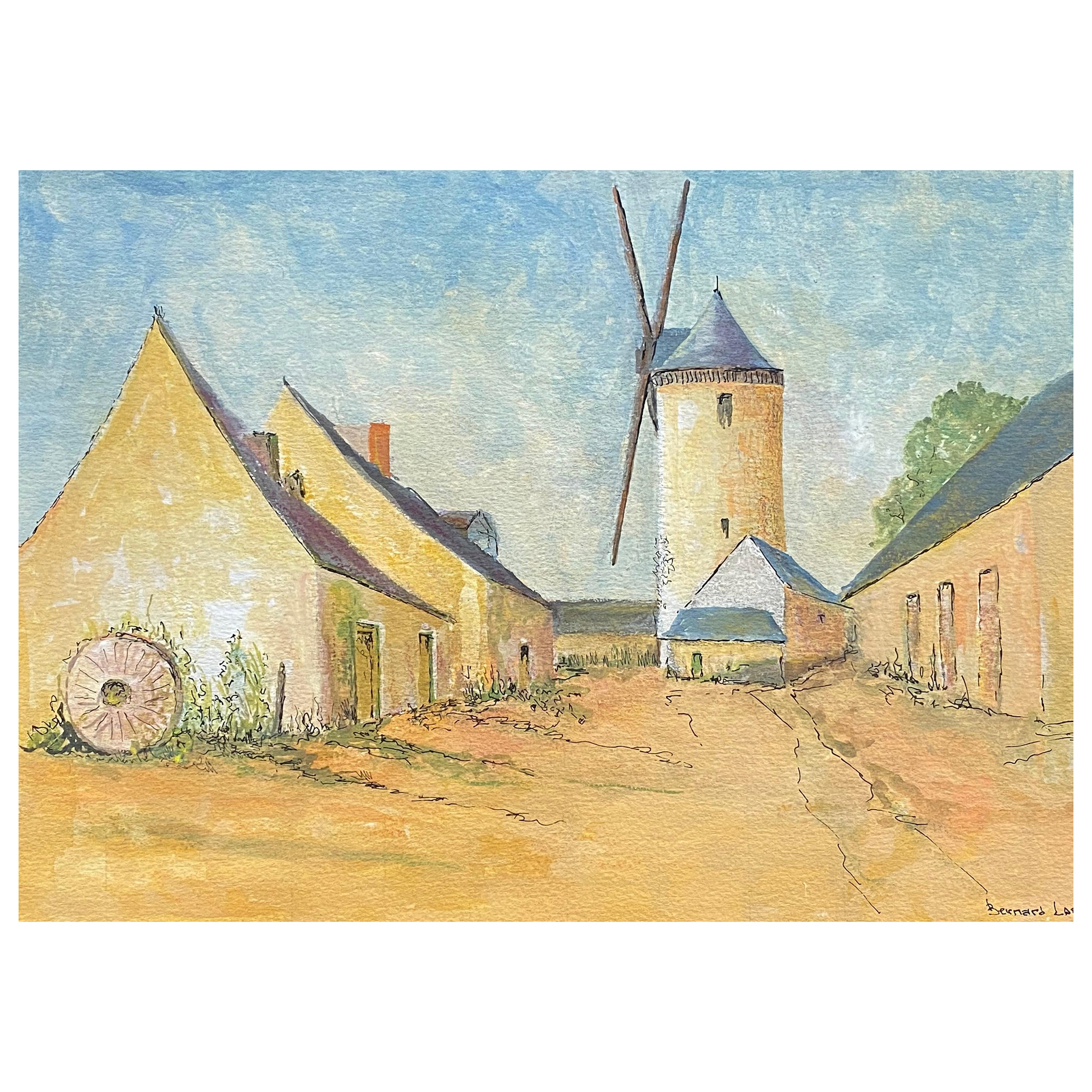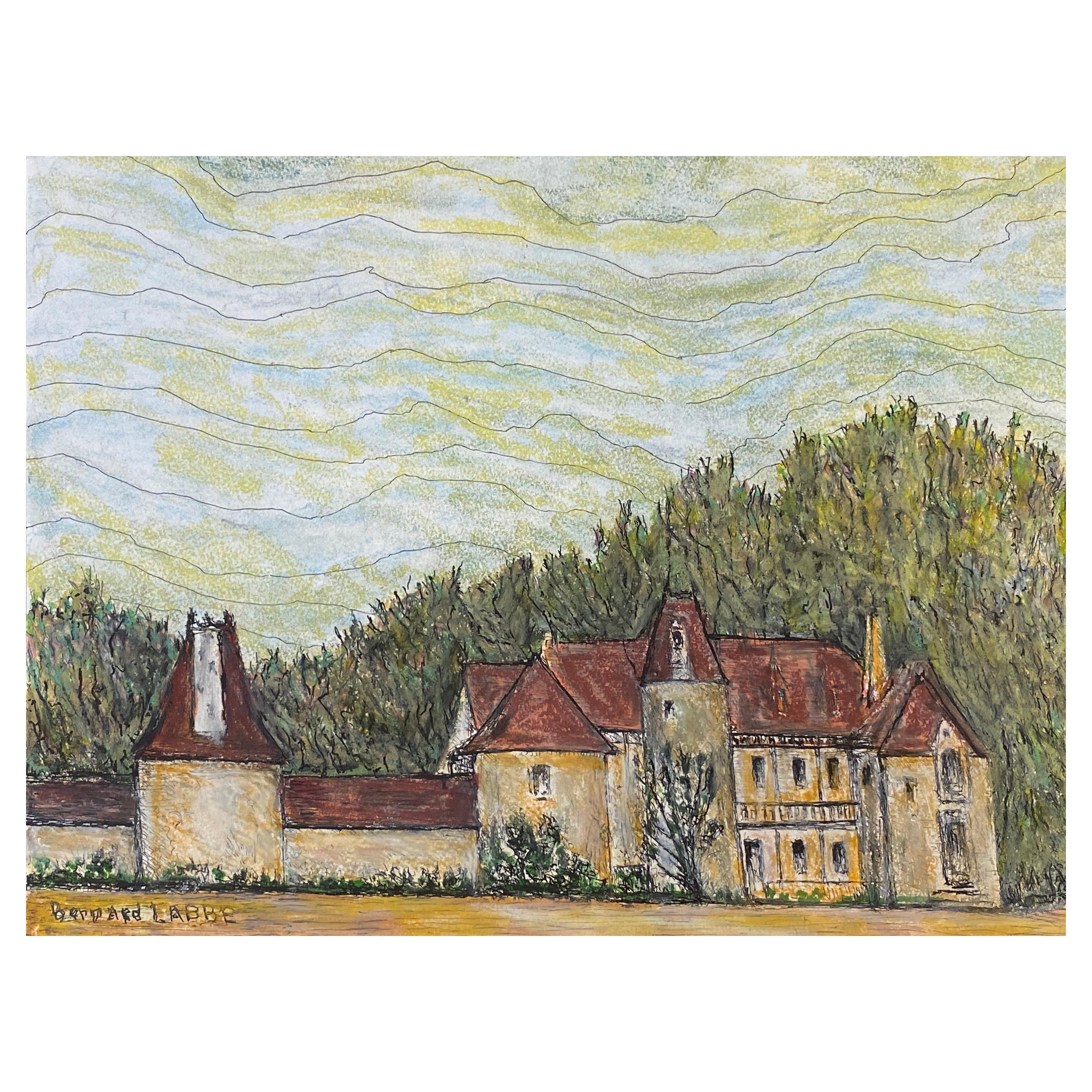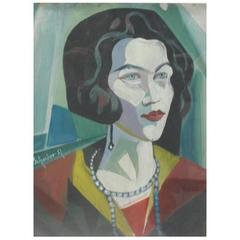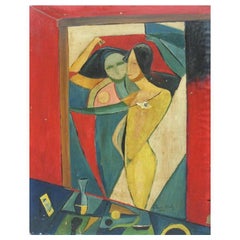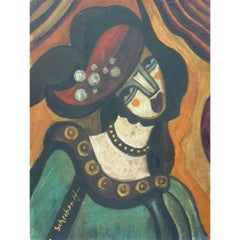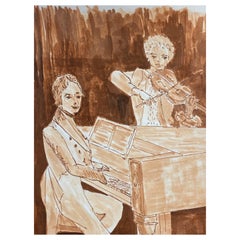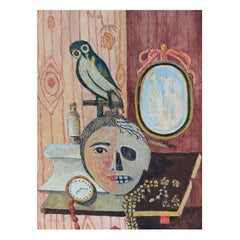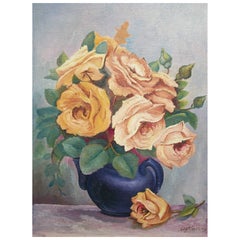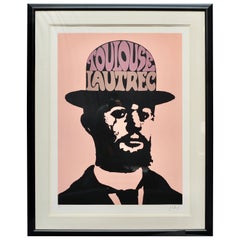Items Similar to Cubist Still Life "Violin" by Early Modernist, Agnes Weinrich, Signed Dated 1922
Want more images or videos?
Request additional images or videos from the seller
1 of 8
Cubist Still Life "Violin" by Early Modernist, Agnes Weinrich, Signed Dated 1922
About the Item
Still life painting (Violin, Flowers), Oil on canvas, by Agnes Weinrich, Signed and dated "22", Unframed: 20" x 16", Framed 27.5 x 23".
Agnes Weinrich (1873-1946) was an early female, American modernist artist at a time when there was little interest in Modern Art in the USA and when few women were artists. She was a ground breaker in modern art. The painting shown is an important example of her mature phase of her work.
A biography from Wiki-pedia follows:
Agnes Weinrich (1873–1946) was one of the first American artists to make works of art that were modernist, abstract, and influenced by the Cubist style. She was also an energetic and effective proponent of modernist art in America, joining with like-minded others to promote experimentation as an alternative to the generally conservative art of their time.
Early years[edit]
Agnes Weinrich was born in 1873 on a prosperous farm in south east Iowa. Both her father and mother were German immigrants and German was the language spoken at home. Following her mother's death in 1879 she was raised by her father, Christian Weinrich. In 1894, at the age of 59, he retired from farming and moved his household, including his three youngest children—Christian Jr. (24), Agnes (21), and Lena (17), to nearby Burlington, Iowa, where Agnes attended the Burlington Collegiate Institute from which she graduated in 1897.[1][2][3] Christian took Agnes and Lena with him on a trip to Germany in 1899 to reestablish links with their German relatives. When he returned home later that year, he left the two women in Berlin with some of these relatives, and when, soon after his return, he died, they inherited sufficient wealth to live independently for the rest of their lives.
Either before or during their trip to Germany Lena had decided to become a musician and while in Berlin studied piano at the Stern Conservatory. On her part, Agnes had determined to be an artist and began studies toward that end at the same time.[1][4] In 1904 the two returned from Berlin and settled for two years in Springfield, Illinois, where Lena taught piano in public schools and Agnes painted in a rented studio. At this time Lena changed her name to Helen. In 1905 they moved to Chicago where Agnes studied at the School of the Art Institute of Chicago under John Vanderpoel, Nellie Walker, and others.[1]
In 1909 Agnes and Helen returned to Berlin and traveled from there to Munich, where Agnes studied briefly under Julius Exter, and on to Rome, Florence, and Venice before returning to Chicago.[5] They traveled to Europe for the third, and last, time in 1913, spending a year in Paris. There, they made friends with American artists and musicians who had gathered there around the local art scene. Throughout this period, the work Agnes produced was skillful but unoriginal—drawings, etching, and paintings in the dominant academic and impressionist styles.[1]
On her return from Europe in 1914, she continued to study art, during the warm months of the year in Provincetown, Massachusetts,[1] where she was a member of the Provincetown Printers art colony in Massachusetts,[6] and during the colder ones in New York City. In Provincetown she attended classes at Charles Hawthorne's Cape Cod School of Art and in New York, the Art Students League.[1]
Drawing of an old woman by Agnes Weinrich, graphite on paper, 11.5 x 7.5 inches.
Hawthorne and other artists established the Provincetown Art Association in 1914 and held the first of many juried exhibitions the following year. Weinrich contributed nine pictures to this show, all of them representational and somewhat conservative in style.[1]
A pencil sketch made about 1915 shows a figure, probably one of the Portuguese women of Provincetown. Weinrich was a metculous draftsperson and this drawing is typical of the work she did in the academic style between 1914 and 1920. She also produced works more akin to the Impressionist favored by Hawthorne and many of his students. When in 1917 Weinrich showed paintings in a New York women's club, the MacDowell Club, the art critic for the Brooklyn Daily Eagle said they showed a "strong note of impressionism."[7]
Broken Fence by Agnes Weinrich, a white-line woodblock made on or before 1917; at left: the woodblock itself; at right: a print pulled from the woodblook.
In 1916 Weinrich joined a group of printmakers which had begun using the white-line technique pioneered by Provincetown artist B.J.O. Nordfelt. She and the others in the group, including Blanche Lazzell, Ethel Mars and Edna Boies Hopkins, worked together, exchanging ideas and solving problems.[1][8] A year later Weinrich showed one of her first white-line prints at an exhibition held by the Pennsylvania Academy of Fine Arts in Philadelphia.[9]
Broken Fence, in its two states—the print and the woodblock from which she made it—show Weinrich to be moving away from realistic presentation, towards a style, which, while neither abstract, nor Cubist, brings the viewer's attention to the flat surface plane of the work with its juxtaposed shapes and blocks of contrasting colors.
Cows Grazing in the Dunes near Provincetown by Agnes Weinrich, white-line woodcut, 10 x 10 1/2 inches
When in 1920 the informal white-line printmakers' group organized its own exhibition, Weinrich showed a dozen works, including one called Cows Grazing in the Dunes near Provincetown. This print shows greater tendency to abstraction than eitherBroken Fence or the prints made by other Provincetown artists of the time. The cows and dunes are recognizable but not presented realistically. The white lines serve to emphasize the blocks of muted colors which are the print's main pictorial elements. Weinrich uses the texture of the wood surface to call attention to the two-dimensional plane—the paper on which she made the print—in contrast with the implicit depth of foreground and background of cows, dunes, and sky. While the work is not Cubist, it has a proto-Cubist feel in a way that is similar to some of the more abstract paintings of Paul Cézanne.[10]
By 1919 or 1920, while still spending winters in Manhattan and summers on Cape Cod, the sisters came to consider Provincetown their formal place of residence.[1][11][12][13] By that time they had also met the painter, Karl Knaths. Like themselves a Midwesterner of German origin who had grown up in a household where German was spoken, he settled in Provincetown in 1919. Agnes and Knaths shared artistic leanings and mutually influenced each other's increasing use of abstraction in their work.[1][14]
The sisters and Knaths became close companions. In 1922 Knaths married Helen and moved into the house which the sisters had rented. He was then 31, Helen 46, and Agnes 49 years old. When, two years later, the three decided to become year-round residents of Provincetown, Agnes and Helen used a part of their inheritance to buy land and materials for constructing a house and outbuildings for the three of them to share. Knaths himself acquired disused structures nearby as sources of lumber and, having once been employed as a set building for a theater company, he was able to build their new home.[15]
Weinrich was somewhat in advance of Knaths in adopting a modernist style. She had seen avant-garde art while in Paris and met American artists who had begun to appreciate it. On her return to the United States she continued to discuss new theories and techniques with artists in New York and Provincetown, some of whom she had met in Paris. This loosely-knit group influenced one another as their individual styles evolved. In addition to Blance Lazzell, already mentioned, the group included Maude Squires, William Zorach, Oliver Chaffee, and Ambrose Webster. Some of them, including Lazzell and Flora Schofield had studied with influential modernists in Paris and most had read and discussed the influential Cubist and Futurist writings of Albert Gleizes and Gino Severini.[16][17]
Mature style[edit]
Woman with Flowers by Agnes Weinrich, circa 1920, oil on canvas, 34 x 30 1/4 inches, exhibited at the Provincetown Art Association exhibition of 1920, made available courtesy of the Association.
Two of Weinrich's paintings, both produced about 1920, mark the emergence of her mature style. The first, Woman With Flowers, is similar to one by the French artist, Jean Metzinger called Le goûter (Tea Time) (1911).[18]
Red Houses by Agnes Weinrich, circa 1921, oil on canvas on board, 24.25 x 25.5 inches; exhibited "Red Houses" at Fifth Annual Exhibition of the Society of Independent Artists.
Like much of Metzinger's work, Le goûter was discussed in books and journals of the time—including one called Cubism co-authored by Metzinger himself.[19] Because the group with which Weinrich associated read about and discussed avant-garde art in general and Cubism in particular, it is reasonably likely that Weinrich was familiar with Metzinger's work before she began her own.
The second painting, Red Houses, bears general similarity to landscapes by Cézanne and Braque. Both paintings are Cubist in style. However, with them Weinrich did not announce an abrupt conversion to Cubism, but rather marked a turning toward greater experimentation. In her later work she would not adopt a single style or stylistic tendency, but would produce both representative pictures and ones that were entirely abstract, always showing a strong sense of the two-dimensional plane of the picture's surface. After she made these two paintings neither her subject matter nor the media she used would dramatically change. She continued to employ subjects available to her in her Provincetown studio and the surrounding area to produce still lifes, village and pastoral scenes, portraits, and abstractions in oil on canvas and board; watercolor, pastel, crayon and graphite on paper; and woodblock prints.[20]
Possessing an outgoing and engaging personality and an active, vigorous approach to life, Weinrich promoted her own work while also helping Karl Knaths to develop relationships with potential patrons, gallery owners, and people responsible for organizing exhibitions. With him, she put herself in the forefront of an informal movement toward experimentation in American art. Since, because of her independent means, she was not constrained to make her living by selling art, she was free to use exhibitions and her many contacts with artists and collectors to advance appreciation and understanding of works which did not conform to the still-conservative norm of the 1920s and 1930s.[1][21][22]
Early in the 1920s, critics began to take notice of her work, recognizing her departure from the realism then prevailing in galleries and exhibitions. Paintings that she showed in 1922 drew the somewhat dry characterization of "individualistic.",[23] and in 1923 her work drew praise from a critic as "abstract, but at the same time not without emotion."[24]
In 1925 Weinrich became a founding member of the New York Society of Women Artists. Other Provincetown members included Blanche Lazzell, Ellen Ravenscroft, Lucy L'Engle, and Marguerite Zorach. The membership was limited to 30 painters and sculptors all of whom could participate in the group's exhibitions, each getting the same space.[23][25][26] The group provided a platform for their members to distinguish themselves from the genteel and traditionalist art that women artists were at that time expected to show[27] and, by the account of a few critics, it appears their exhibitions achieved this goal.[1][28][29][30]
In 1926 Weinrich joined with Knaths and other local artists in a rebellion against the "traditional" group that had dominated the Provincetown Art Association. For the next decade, 1927 through 1937, the association would mount two separate annual exhibitions, the one conservative in orientation and the other experimental, or, as it was said, radical.[31][32] Both Weinrich and Knaths participated on the jury that selected works for the first modernist exhibition.[11]
Still Life by Agnes Weinrich, circa 1926, oil on canvas, 17 x 22 inches. Permission to use granted by Christine M. McCarthy, Executive Director, Provincetown Art Association and Museum. The painting was the gift of Warren Cresswell.
Weinrich's painting, Still Life, made about 1926, may have been shown in the 1927 show. Representative of some aspects of her mature style, it is modernist but does not show Cubist influence. The objects pictured are entirely recognizable, but treated abstractly. Although fore- and background are distinguishable, the objects, as colored forms, make an interesting and visually satisfying surface design.
In 1930 Weinrich put together a group show for modernists at the GRD Gallery in New York. The occasion was the first time a group of Provincetown artists exhibited together in New York. For it she selected works by Knaths, Charles Demuth, Oliver Chaffee, Margarite and William Zorach, Jack Tworkov, Janice Biala, Niles Spencer, E. Ambrose Webster, and others.[1][23]
Later years[edit]
Weinrich turned 60 on July 16, 1933. Although she had led a full and productive life devoted to development of her own art and to the advancement of modernism in art, she did not cease to work toward both objectives. She continued to work in oil on canvas and board, pastel and crayon on paper, and woodblock printing. Her output continued to vary in subject matter and treatment. For example, Still Life with Leaves, circa 1930 (oil on canvas, 18 x 24 inches) contains panels of contrasting colors with outlining similar to Knaths's style. Movement in C Minor, circa 1932 (oil on board, 9 x 12 inches) is entirely abstract. It too relates to Knaths's work, both in treatment (again, outlined panels of contrasting colors) and in its apparent relationship to music, something in which Knaths was also interested. Fish Shacks, circa 1936 (monochrome woodblock print) is severely abstract and has a strong Cubist feel. Untitled Abstraction, circa 1938 (oil on canvasboard, 12.25 x 12 inches) is very different from the abstract work of the earlier 1930s. It is a geometric abstraction showing influence of Wassily Kandinsky[33] consisting of rectilinear color panels in cool tones with to contrasting panels in ochre and red. Floral Still Life, circa 1940 (Crayon on paper, 7 x 9.5 inches) contains a frame within a frame, emphasizing the surface plane dramatically, and is also entirely abstract. Its composition consists of star-like shapes in blue and magenta in a lively pattern against a dark, textured background.
Critical reception[edit]
Despite the quality of her work and despite the energy and skill with which she worked both to develop her own talent and to further the progressive movement in American art, Weinrich received little recognition during her lifetime and has not received much more since her death. Most accounts of her life and work repeat a few salient facts. They do not provide citations and some of their claims cannot be confirmed.[34][35] Only one person, Louise R. Noun, studied her in detail. See the exhibition catalog she co-wrote and the article by her, both cited in the "Further reading" section below.
There is no evidence that Weinrich was ever represented by a commercial gallery and it is likely that she made her sales via exhibitions and out of her studio. She did not usually provide date, name, place, or subject on her works and kept few records of what she produced. For these reasons, and because (a) they were not inventoried by art dealers in her lifetime and (b) she made a lot of art that was not sold, there is often doubt about the provenance of any given piece.
Exhibitions[edit]
This is a selective list of exhibitions in which she participated during her life. Its main source is Louise Noun's article on Weinrich in Woman's Art Journal,[1] supplemented by contemporary news accounts in The New York Times, the Brooklyn Daily Eagle, the New York Evening Post, The Philadelphia Inquirer, and The Christian Science Monitor.
1915 onward: Provincetown Art Association
1917: Pennsylvania Academy of Fine Arts
1917: Pennsylvania Academy of Fine Arts, Philadelphia
1917-23: Society of Independent Artists, New York
1919: Art Institute of Chicago
1920: Boston Arts Club
1926 onward: New York Society of Women Artists
1928: Grace Horn Gallery, Boston
1929: Pennsylvania Academy of Fine Arts, Philadelphia
1932: Boston Public Library
1936: Harley Perkins Gallery, Boston (solo)
1938: Boston Society of Independent Artists
1938: Washington Public Library, Washington, D.C.
1939: Corcoran Gallery Biennial, Washington, D.C.
1939: Fogg Art Museum Twentieth Century Club, Boston
1939: Witherstine Gallery, Boston
1939: Institute of Modern Art, Boston
1945: Woljeska Gallery, Brooklyn, New York
- Creator:Agnes Weinrich (Artist)
- Dimensions:Height: 16 in (40.64 cm)Width: 20 in (50.8 cm)Depth: 0.1 in (2.54 mm)
- Style:Modern (Of the Period)
- Materials and Techniques:
- Place of Origin:
- Period:
- Date of Manufacture:1922
- Condition:Repaired: professional repair to a small cut. Wear consistent with age and use.
- Seller Location:New York, NY
- Reference Number:Seller: AW221stDibs: LU79359437933
About the Seller
5.0
Gold Seller
Premium sellers maintaining a 4.3+ rating and 24-hour response times
Established in 1997
1stDibs seller since 2004
223 sales on 1stDibs
Typical response time: 1 hour
Associations
20th Century Specialists
- ShippingRetrieving quote...Shipping from: New York, NY
- Return Policy
Authenticity Guarantee
In the unlikely event there’s an issue with an item’s authenticity, contact us within 1 year for a full refund. DetailsMoney-Back Guarantee
If your item is not as described, is damaged in transit, or does not arrive, contact us within 7 days for a full refund. Details24-Hour Cancellation
You have a 24-hour grace period in which to reconsider your purchase, with no questions asked.Vetted Professional Sellers
Our world-class sellers must adhere to strict standards for service and quality, maintaining the integrity of our listings.Price-Match Guarantee
If you find that a seller listed the same item for a lower price elsewhere, we’ll match it.Trusted Global Delivery
Our best-in-class carrier network provides specialized shipping options worldwide, including custom delivery.More From This Seller
View AllPortrait of an Elegant Woman, Signed Hugo Scheiber
By Hugó Scheiber
Located in New York, NY
Watercolor / painting signed Hugo Scheiber: Budapest (1873-1950).
Hugo Scheiber was born in Budapest in 1873. At the age of eight, he moved with his family from Budapest to Vienna. ...
Category
Mid-20th Century Hungarian Mid-Century Modern Paintings
European Midcentury Cubist Painting 'Nude' by Koroly Glonczy, Hungary, 1957
By Koroly Glonczy
Located in New York, NY
Cubist Painting by Hungarian Painter, Koroly Glonczy.
Oil on cardboard.
References: Modern and contemporary art. European 20th century, Mid-Century Modern.
Category
Vintage 1950s Hungarian Modern Paintings
Materials
Paint
Painting 'October in the Cantina' by Sergio Agostini, Italy, 1960
By Sergio Agostini
Located in New York, NY
"Ottobre in Cantina"
Painting, oil on canvas by Italian artist Sergio Agostini, Rome, 1960.
Signed on lower left with sticker from original exhibition at Galleria L'88 on Via M...
Category
Mid-20th Century Italian Modern Paintings
Materials
Canvas
Portrait ‘Woman with Tilted Head’ Signed Hugo Scheiber
By Hugó Scheiber
Located in New York, NY
Painting, oil in cardboard, signed H Scheiber (Budapest 1873- 1950).
Hugo Scheiber was born in Budapest in 1873. At the age of eight, he moved with his family from Budapest to Vie...
Category
Early 20th Century Hungarian Modern Contemporary Art
Materials
Paint
Painting on Canvas, "La Cuisine Aux Fleurs" by Gerard Economos
By Gerard Economos 1
Located in New York, NY
Painting. Acrylic on canvas by Gerard Economos (French,1935-)
Gerard Economos is known for his passionate, intensely colored abstract compositions and large acrylic paintings that have been performed live in front of audiences in 12 countries. Economos has had over 88 events over the last 57 years and his work is now in collections in over 34 countries. He started Live Performances with the Greek avante-garde composer and architect, Iannis Xenakis during a Sound Festival; Subsequently he developed the "Une Musique a Voir" (A music to see) concept.
'La Cuisine aux Fleurs' (Cooking with Flowers) was a series of paintings initiated at the request of the renowned French Chef, Raymond Oliver in 1975 who wished to have his recipes illustrated. They have been rarely shown in public.
For an illustrated 15 page biography of Economos please contact Thomas Gallery Ltd...
Category
Mid-20th Century French Mid-Century Modern Paintings
Materials
Canvas, Acrylic
$3,000 Sale Price
40% Off
Painting, Oil, 'Street Scene' Signed Bela Kadar
By Bela Kadar
Located in New York, NY
Painting, Street Scene, Signed Bela Kadar, (Hungary 1877-1955), un-framed, oil on board.
Bela Kadar was born in Hungary in 1877. Amongst his early interests was mural painting. Like many of the artists of his day he was drawn to Paris and Berlin, and by 1910 he had visited both cities twice. In 1923, Kadar showed his paintings in Berlin at the invitation of Herwath Walden. Walden was an important figure in the German avant-garde, being the publisher of the journal Der Sturm which featured the works of Franz Marc, Paul Klee, Wassily Kandinsky, Marc Chagall and Oskar Kokoschka. During the group exhibition at Walden's gallery with other artist's of Der Sturm, Kadar met Katherine Dreier whose Societe Anonyme was instrumental in bringing the work of the European avant-garde to New York. With her help two major exhibitions of his work were planned for the Brooklyn Museum of Art, the second of which in September 1928 Kadar travelled from Europe to attend.
Bela Kadar incorporated themes of Hungarian...
Category
Vintage 1930s Hungarian Mid-Century Modern Paintings
You May Also Like
1950's French Modernist/ Cubist Painting Signed, Pianist & Violin Duet
Located in Cirencester, GB
The Pianist & Violin Duet
by Bernard Labbe (French mid 20th century)
signed original watercolour/ gouache painting on paper, unframed
size: 11.75 x 8.75 inches
condition: very go...
Category
Mid-20th Century Modern Paintings
Materials
Other
20th Century French Modernist Cubist Painting Labbe, Still Life
By Bernard Labbe
Located in Cirencester, GB
Still Life
by Bernard Labbe (French Mid-20th Century)
original watercolor, ink and gouache on paper
size: image 7.75 x 11.75 inches
size: sheet 10 x 14 inches
unsigned, stamped verso
condition: very good, right side of sheet (white margin) cut slightly unevenly, ready to be enjoyed
provenance: the artists atelier/ studio, France (stamped verso)
A still life tableaux of objects, perhaps some surrealism in Labbe's work on this one. A bird perches above a face which is depicted as half skeletonised, a decorative mirror hangs...
Category
Late 20th Century French Paintings
Materials
Other
Vintage Still Life Oil Painting on Board - Signed & Dated - Canada - Circa 1975
Located in Chatham, ON
OSKAR - Vintage floral still life oil painting on artist's canvas board - signed and dated - unframed - Canada - circa 1975.
Ex...
Category
Mid-20th Century Canadian Mid-Century Modern Paintings
Materials
Canvas, Paint
Large Toulouse Lautrec by Peter Max in Peach Pink, Signed and Framed
By Peter Max
Located in Los Angeles, CA
This is the largest of the Toulouse Lautrec portraits by famed artist Peter Max in peach pink. Professionally framed, signed and numbered.
Category
Vintage 1960s American Modern Contemporary Art
Materials
Paper
$10,500 Sale Price
25% Off
1950's French Modernist/ Cubist Painting Signed, The WindMill
Located in Cirencester, GB
The Windmill
by Bernard Labbe (French mid 20th century)
signed original watercolour/ gouache painting on paper , unframed
size: 10 x 14 i...
Category
Mid-20th Century Modern Paintings
Materials
Other
1950's French Modernist/ Cubist Painting signed, French Chateau
Located in Cirencester, GB
French Chateau
by Bernard Labbe (French mid 20th century)
signed original watercolor/ gouache painting on artist paper, unframed
size: 13 x 15 inches
condition: very good and rea...
Category
Mid-20th Century Modern Paintings
Materials
Other
